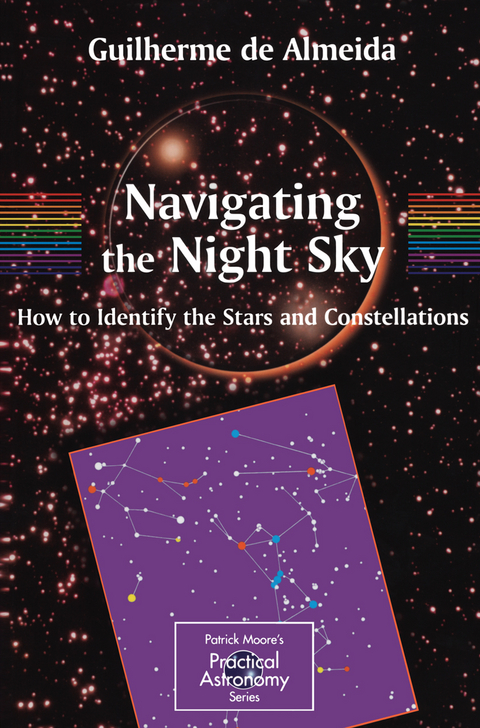
Navigating the Night Sky
Springer London Ltd (Verlag)
978-1-85233-737-7 (ISBN)
Onee the Sun has gone down, on clear nights without moonlight, the sky is inhabited by thousands oflumi- nous dots of various eolours and levels ofbrightness. The speetacle offered by a starry sky is both grand and sublime, especially in less urban areas. In plaees where night illumination and air pollution are that mueh more intense, it is well known that we are unable to see as many stars as in a rural region. Nevertheless, this need not be overstated: on the out- skirts of cities, or even in the cities themselves, pro- vided you ehoose the more favourable areas, it is still possible to see many stars. Navigating the Night Sky is aimed at anyone who marvels at the night sky and who wishes to leam to reeognise eonstellations and identify the brightest stars by name. It is essentially a praetieal book, whieh aeeompanies the reader on their eelestial explorations, guiding their way around the stars. Prior knowledge is not required in order to use the book. Anyone ean enjoy it, from the youngest student to the interested adult.
1 The Constellations.- 1.1 The Viewing Location.- 1.2 Adapting the Eyes to Darkness.- 1.3 What Is the Next Step Towards Identifying Constellations and Stars?.- 1.4 Where to Start?.- 2 The Stars.- 2.1 How Far Away Are the Stars?.- 2.2 Are the Stars that Are Most Apparent in the Sky Brighter than the Others?.- 2.3 Why Do Stars Twinkle?.- 2.4 Do the Stars Move?.- 2.5 What is the Size and Mass of a Star?.- 2.6 How are Stars Formed and How Long Do they Live?.- 2.7 The Colours of the Stars.- 2.8 The Brightness of the Stars.- 2.9 Do Stars Always Have the Same Brightness?.- 2.10 “Stars” that are not Stars.- 3 The Celestial Sphere.- 3.1 So Just What Are the Constellations?.- 3.2 Measuring the Sky.- 3.3 What is the Ecliptic?.- 3.4 The Ecliptic and the Positions of the Planets in the Sky.- 3.5 The Ecliptic and the Signs of the Zodiac.- 3.6 How to Find Your Way Around the Sky.- 4 Identifying the Constellations and the Brightest Stars.- 4.1 Alignments of Stars.- 4.2 Sky Maps and Road Maps.- 4.3 Using Identification Maps.- 4.4 Ursa Major: The Best Starting Point.- 4.5 Identification Maps.- 5 The Sky Seen from the Southern Hemisphere.- 5.1 Other Viewing Locations.- 5.2 What Does the Sky Look Like in the Southern Hemisphere?.- 5.3 Stars that Cannot be Seen from Latitudes around 40° N.- 5.4 Characteristics of Constellations Close to the Celestial South Pole.- 5.5 The Southern Cross: A Good Starting Point.- 6 The Milky Way.- 7 Celestial Chart.- 8 The Sky and the Four Seasons of the Year.- 8.1 What To Do Next.- 8.2 Constellations with which the Reader Is Already Familiar.- Appendices.- 1 Examples of Ancient Representations of Some Constellations.- 2 How to Locate the Celestial North Pole in the Sky.- 3 Movement of the Sun in Line with the Constellation Ophiuchus.- 4 Bright StarsShown on the Maps and on Other Diagrams in this Book.- 5 Constellations that Are Easy or Difficult to Recognise.- 6 Useful Data Regarding the Identification and Visibility of the Constellations.- 7 Approximate Latitudes of Some Cities in the Southern Hemisphere, or Close to the Equator.- 8 Angular Distances Between Some Stars Visible between the Latitude Coordinates of 37° N and 42° N.- 9 Angular Distances Between Some Stars in the Celestial Southern Hemisphere.- 10 Symbols of the Sun, Moon and Planets.- 11 Star Names.- 12 The Greek Alphabet.
| Reihe/Serie | The Patrick Moore Practical Astronomy Series |
|---|---|
| Zusatzinfo | XII, 205 p. |
| Verlagsort | England |
| Sprache | englisch |
| Maße | 155 x 235 mm |
| Themenwelt | Sachbuch/Ratgeber ► Natur / Technik ► Weltraum / Astronomie |
| Naturwissenschaften ► Physik / Astronomie ► Astronomie / Astrophysik | |
| ISBN-10 | 1-85233-737-0 / 1852337370 |
| ISBN-13 | 978-1-85233-737-7 / 9781852337377 |
| Zustand | Neuware |
| Haben Sie eine Frage zum Produkt? |
aus dem Bereich


